If you’re anything like me, there’s nothing more satisfying than waking up to the smell of freshly baked bread. It’s one of life’s simple luxuries. But let’s be honest — making bread from scratch isn’t always simple. Between kneading, proofing, and cleaning up flour explosions, it can feel like a full-time job.
That’s why I fell in love with bread-making machines. They take away the effort but leave all the goodness. The problem? Not everyone wants to spend hundreds on a fancy model with a dozen features they’ll never use. That’s where budget-friendly bread makers come in — and today, I’m sharing my personal recommendations for affordable, high-performing options that have earned a permanent place in my kitchen rotation.
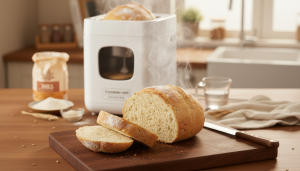
Before we dive into my top picks, here’s what you’ll learn in this post:
-
Why budget bread makers are worth considering
-
The features that actually matter
-
My favorite affordable models for 2025
-
Simple tips to get bakery-quality results
-
Quick answers to common questions
Grab your coffee — this one’s for anyone who wants fresh bread without the hefty price tag (or the arm workout).
Why I Love Budget Bread Makers
I’ve tested both premium and budget-friendly bread machines over the years, and here’s the truth: price doesn’t always equal better bread. Sure, expensive models offer fancy add-ons like automatic fruit dispensers or gluten-free cycles, but unless you’re a professional baker, you probably won’t use half of them.
Budget models, on the other hand, focus on the essentials — kneading, proofing, and baking — and they often do it beautifully. They’re compact, reliable, and easy to use. Plus, they won’t make you feel guilty about your next grocery splurge.
And let’s be honest: a well-baked loaf from a $100 machine tastes every bit as good as one from a $300 gadget. The key is choosing the right model for your needs.
Key Features I Look for in an Affordable Bread Maker
1. Capacity and Loaf Size
Think about how much bread you actually eat. For small households or solo bakers, a 1–1.5 lb capacity works perfectly. Families might prefer a 2 lb option. Most affordable models give you multiple size settings, which is great for minimizing waste.
2. Preset Programs
You don’t need 20 baking modes — but a few useful ones go a long way. I look for settings like basic white, whole wheat, sweet bread, and dough. Some models even offer a quick bake option for when you’re impatient (guilty as charged).
3. Timer and Keep Warm Functions
A programmable delay timer is a game changer. Imagine setting your ingredients overnight and waking up to the smell of fresh bread. The keep-warm feature is also handy if you tend to forget the loaf after the bake cycle ends — something I’ve done more times than I’ll admit.
4. Ease of Cleaning
If a bread machine is a pain to clean, I promise you won’t use it. I prefer non-stick pans and removable kneading paddles that make cleanup quick and painless.
5. Noise Level
Some budget models can get a little noisy during kneading. It’s not a deal-breaker, but if you live in an apartment, you’ll want a quieter one.
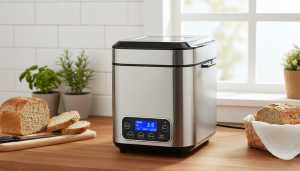
My Top Picks for the Best Budget Bread Makers (2025)
Here are my personal favorites that have proven to be affordable, dependable, and easy to use.
1. Hamilton Beach 2 Lb Digital Bread Maker
If I had to recommend one entry-level bread machine, this would be it. It’s user-friendly, versatile, and usually costs under $100.
Why I Like It:
It offers 12 settings, including gluten-free and dough-only options. The digital display is intuitive, and the non-stick pan makes cleanup a breeze. It’s also compact enough for smaller kitchens.
Best For: Beginners and casual home bakers.
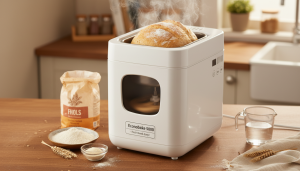
2. Oster Expressbake Breadmaker
This one’s a personal favorite when I’m short on time. The Expressbake setting can whip up a loaf in under an hour — perfect for spontaneous sandwich cravings.
Why I Like It:
The control panel is simple, and the results are surprisingly consistent. It even includes a viewing window (which I love for checking progress without losing heat).
Best For: Busy professionals or anyone who values speed over extras.
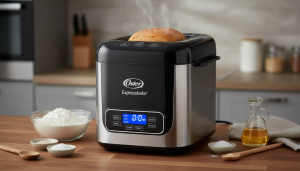
3. Cuisinart Compact Automatic Bread Maker
Slightly pricier but still budget-friendly, this model feels more premium than its price tag.
Why I Like It:
It has a sleek design and solid build. The crust control feature lets me choose between light, medium, or dark — because, yes, I am that particular about my toast color.
Best For: Style-conscious bakers who want durability.
4. Amazon Basics Bread Machine
Don’t underestimate this one. It may not win design awards, but it performs surprisingly well for its price.
Why I Like It:
It’s incredibly simple to use — no unnecessary settings or steep learning curve. Ideal if you just want straightforward, fresh bread.
Best For: Budget-conscious users and first-time buyers.
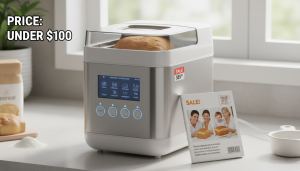
5. Panasonic Automatic Bread Maker
If you’re willing to stretch your budget a little, Panasonic models are known for reliability. This one includes 13 programs and consistent kneading performance.
Why I Like It:
The bread texture is spot-on — soft inside, perfectly browned outside.
Best For: Home bakers who want a dependable long-term option.
How I Get the Most Out of My Bread Maker
Using a bread maker is easy, but getting great results takes a few small habits. Here’s what I’ve learned:
-
Measure accurately: Baking is science, not guesswork. A tablespoon too much flour can make a loaf dense.
-
Use fresh yeast: It’s small but crucial. Expired yeast = flat bread.
-
Don’t rush cooling: Let the loaf rest before slicing — this helps maintain texture.
-
Experiment with recipes: Once you’ve nailed the basics, try adding seeds, herbs, or cheese.
-
Clean after every use: Trust me, dried dough in the corners is a nightmare to remove later.
(Pro tip: Pair your fresh loaf with perfectly sliced toppings using a sharp knife. My post on best kitchen knife set 2025 covers a few affordable options that make kitchen prep even smoother.)
Common Questions I Get About Bread Makers
1. Are cheap bread makers reliable?
Absolutely — as long as you choose a reputable brand. Budget-friendly models often last several years with regular use.
2. Can I make gluten-free bread?
Yes, some models offer a gluten-free setting. For others, you can still bake gluten-free loaves manually by adjusting recipes slightly.
3. Is it cheaper to make bread at home?
In the long run, yes. Homemade bread costs less per loaf and you control the ingredients. Plus, no preservatives!
4. How long does a bread maker last?
On average, 4–6 years. Keep it clean, don’t overload it, and it’ll stay reliable for years.
5. Do I need bread flour?
It helps, but all-purpose flour works fine. Just expect a slightly softer loaf.
My Final Thoughts
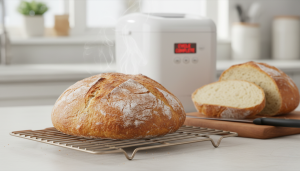
Investing in a budget bread maker has genuinely changed how I bake. It saves time, money, and gives me control over every ingredient. Whether you’re a total beginner or someone who just wants fresh loaves without paying premium prices, there’s a model out there for you.
For most people, I’d recommend starting with something like the Hamilton Beach or Oster Expressbake — both offer excellent value and reliability.
Once you start baking your own bread, you might find it’s hard to go back to store-bought loaves. And honestly, that’s a “problem” I’m happy to have.